September 3, 1927
Los Angeles
If you’re planning to escape the heat this Labor Day by going boating on Lake Arrowhead, don’t forget to take along your radio!
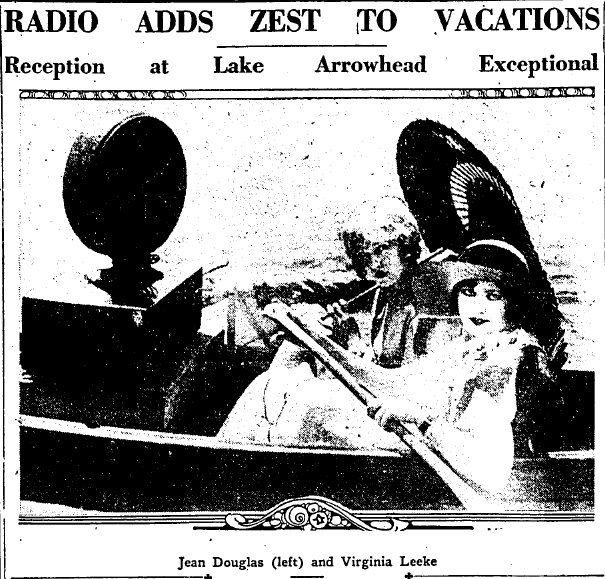
September 3, 1927
Los Angeles
If you’re planning to escape the heat this Labor Day by going boating on Lake Arrowhead, don’t forget to take along your radio!


August 25, 1927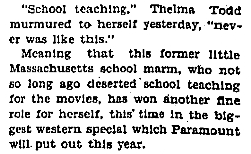
Hollywood
It was announced today that a plucky schoolmarm from Back East is cast as female lead in Paramount’s big western outing this year, “The Gay Defender.” She’ll be working with Richard Dix, who’s portraying Joaquin Murrietta in this colorful Gold Rush saga of ’48, filmed in our own Central California!
Well, that’s an exciting story, you say. But so began the acting career…of doom!
I was seven years old when I found my purpose in life—to chase braless, acid-tongued women. And what set me on this career path? I’d just seen Monkey Business, where I witnessed Lucille Briggs…as portrayed by Thelma Todd.
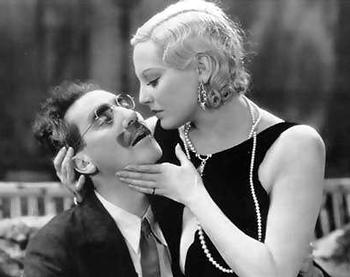
Thelma and me, 1931.
Thelma, you two-fisted, drunken, nymphomaniacal brainiac Yankee; the pinups portray her as syrupy kute, but those of us with Thelma in our blood know you as the sexier, smarmier Dorothy Parker. And whomever may have a penchant for Hollywood’s Babylonian side couldn’t do better than delve deep into the mysteries of Ms. Todd—did Roland West lock her in the garage, the Lincoln’s motor running? Was she whacked by Lucky Luciano over sex and gambling interests at her Thelma Todd Café on PCH? Was she killed by her ex-husband, notorious womanbeating, bootlegging pimp Pat DiCicco? For all the grime and gore you can shake a stick at, go here.
Though don’t believe everything you read there—like the repetition of that fictitious Luciano business from Hollywood Babylon—and while they mention Thelma’s funeral at Forest Lawn, true, her 3:30pm December 19 private service was at Wee Kirk o’ the Heather, remember, when you see images of her casketed, they’re from when she lay in state at the (recently closed) Pierce Brothers mortuary on West Washington that day from 8am til 1pm (the window behind Thelma is the window on the left).

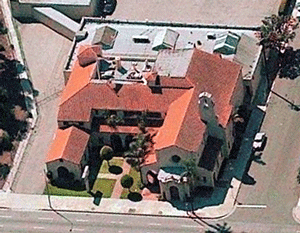

August 20, 1927
Malibu
In this case “A Good Man is Hard to Find” is not a reference to Flannery O’Connor’s allegorical tale of good and evil, faith and redemption – no, we are talking about finding a good man, one who won’t desert his date on a quiet stretch of highway at the first sign of trouble, escorting her safely to her home instead.
Thelda Gollett, of 456 Westminster Avenue, and Arthur Israel of 756 1/2 South San Pedro Street, were taking a relaxing drive in the Los Flores Canyon area when a man stepped out onto the roadway waving a revolver, and ordered them to stop. Upon seeing the bandit Thelda jumped from the car and started to run, with the gun wielding crook only a few yards behind her.
Rather than stay and protect his date, Arthur spun his car around and screeched off in the direction of Los Angeles.
Arthur wouldn’t learn of Thelda’s fate until after she had returned home unscathed. She reported to police that she hidden beneath a bridge until the highwayman disappeared. Once the coast was clear she was rescued by a passing truck – driven by a good man.
We suspect that this was the couple’s last date. Maybe Thelda will keep company with that chivalrous truck driver.
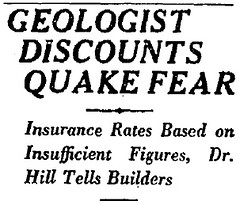
August 13, 1927
Los Angeles
Eminent geologist Dr. Robert T. Hill has stated unequivocally that Southern California is in no danger from earthquakes.
In his keynote address to the Building Owners and Managers’ Association, Dr. Hill told the group that “there is not a thread of evidence on which to hang a prophecy of an earthquake in this district”. He went on to say that “our occasional little earth tremors merely give me a little thrill in the day time or rock me sounder to sleep at night”. Dr. Hill’s assertion that the Los Angeles area is seismically stable was music to the ears of association members who have been vigorously protesting recent insurance rate increases. The geologist characterized the insurance carriers as “alarmist”.
Well, Dr. Hill, dial ahead six years and set your “alarmist” for 5:55 pm on March 10, 1933 when a sizeable earthquake will devastate sections of Long Beach and kill 115 people.
Dr. Hill was conspicuously absent from local newspapers following the Long Beach quake – not even a “no comment”. We hope he wasn’t spending time in this building – whatever it was.

August 4, 1927
San Pedro
That Ernest M. Branson just couldn’t leave well enough alone. He was a member in good standing of San Pedro 51, Knights of the Ku Klux Klan, and all was fine and hunky-dory, until he started stirring the pot with his talk. So from under the sheet came a big boot, and out went Ernest; now, Ernest says he was libeled in the written order that banished him from the Kluxers.
What was it ever did Ernest say? To hell with the flag? Hooray for Hebrews? Eucharist is yummy? Thomas Jefferson got it on with Sally Hemmings?
No, all he did was stir up some internal dissension inside the Klan, which resulted in his ouster (maybe he sided with Madge over DC.) That’s gotta be the worst libel of all—accused of making mishegas in the klavern!
So now Ernest has filed a $25,000 ($275,749 USD2006) libel suit against none other than Exalted Cyclops Karl K. Keller.
(Yes, Karl K. Keller. I bet his real name was Herman Flork.)
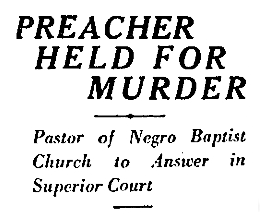
July 29, 1927
Long Beach
Reverend W. R. Hardy, pastor of the African Methodist Episcopal Church of Long Beach, had a little quarrel with one Joe Dianty, Montegrin bootblack, in front of Dianty’s home at 1225 California Avenue.
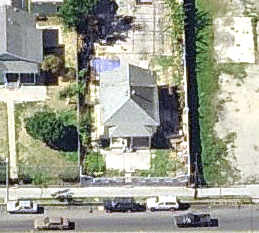 Of the two things a pastor can draw from his waistband—his bible or his revolver—Rev. Hardy elected to draw the latter. He shot Dianty in the abdomen, and when Dianty turned the other cheek (to run away) Hardy shot him again in the neck and shoulder. Dianty died on the sidewalk.
Of the two things a pastor can draw from his waistband—his bible or his revolver—Rev. Hardy elected to draw the latter. He shot Dianty in the abdomen, and when Dianty turned the other cheek (to run away) Hardy shot him again in the neck and shoulder. Dianty died on the sidewalk.
On October 13, Hardy is convicted of manslaughter after a week-long trial involving thirty witnesses for the prosecution and half that number for the defense; on October 27 he is given one to ten in San Quentin.
Now, would that he have had the jawbone of an ass…
July 5, 1927
Venice
It was April 12, 1924, south of the border down Mehico way, when two brigands confronted Fedosis Alvarado on his ranch near Monte Escobeda, stole $2400 and shot him dead when he tried to defend his property. Arrested for the crime, Santiago Figueroa used the victim’s money to avoid prison time.
Fedosis’ daughter, Maria Alvarado Gomez, was not satified with the verdict, and when she heard her father’s killer had moved to the beach at Los Angeles, she followed, taking a home at 1508 Pennsylvania Avenue, Santa Monica. She haunted the public spaces along the shore, not in a spirit of seaside pleasure seeking, but in single-minded pursuit of the man whose face was burned into her brain.
Last night, as crowds packed the streets of Venice for Fourth of July revelry, she finally saw him and cried out to her friends, "There he is, the murderer of my father, hold him, don’t let him get away!" But in Spanish, because, you know, everyone involved spoke Spanish.
Traffic Officer Carter happened on the scene and took the players into custody, calling in auto camp manager Howard Wesson to translate. Once the story was explained, an envoy was dispatched to the Mexican Consulate, to determine if Figueroa was wanted in his homeland.
Obviously not, since there was no follow up story on the incident. Poor Maria. Should there be a next time, may we suggest she be prepared to exact her own swift justice on her prey, and not make the mistake of trusting law or nations to supply a daughter’s long overdue justice.
May 31, 1927
Venice
If you needed proof of how the world has changed in 80 years, you need look no further than the news stories surrounding the police search for and arrest of Joe Hordeman, "elderly" war veteran and pipe murder suspect, and of Hordeman’s "December" romance with divorcee Victoria Woods, who he met at an "old folks dance" at the Sawtelle veteran’s home in late 1925.
Hordeman was enamored of Mrs. Woods and hoped to marry or go into business with her, but she found other men more fascinating. She enjoyed dancing, something Hordeman was not inclined to do with her, despite their initial meeting place. Recently she had befriended Emma O’Bell, who became her roommate and encouraged her friend’s active romantic life.
Hordeman couldn’t stand it. He bought a lead pipe and went to Mrs. Woods’ home at 109 Brooks Avenue when he thought two of her suitors would be in attendance. But he found only Mrs. Woods and Mrs. O’Bell, sitting on the porch. Incensed, he asked Mrs. Woods to go inside where they could discuss his concerns, and a raving argument erupted. Hordeman pulled out his pipe and beat her unconscious, then took a knife and neatly cut her Achilles tendons to ensure she would never dance again. He needn’t have bothered save for the symbolism; she died of her injuries. Mrs. O’Bell saw the attack through the window and rushed inside, and was herself badly beaten. Saved from injury was Mrs. Woods’ daughter, who had gone to Chicago the morning of the slaying to speak with her father about her parents reuniting.
The whole horrible affair was witnessed by 15-year-old neighbor Catherine Franklin through her kitchen window, but the dishwashing girl was so traumatized that she did not immediately cry out, and the killer walked down the alley and escaped. He turned himself in the next day after registering at a Los Angeles hotel and mistakenly crossing the d in Ford, when he had meant to use the pseudonym Fort; he was convinced this error would lead to his quick arrest. At his trial in August, Hordeman, who had once claimed he dare not confess lest "the Klan" kill him for harming Mrs. Woods, suddenly changed his plea to guilty after Mrs. O’Bell testified, and was sentenced to one year to life in San Quentin.
The decrepit Hordeman was variously reported as being 52, 60 or 62, old lady Mrs. Woods 55.
Seems a traveling sewing machine salesman dropped by Mrs. L.K. Sitton’s home at 1004 Electric Avenue and, when she complained of a slight headache, mentioned that he was an expert in Swedish massage and offered to relieve her.
The Times reported that "He fled… when his victim screamed and her husband returned unexpectedly." Though we wonder if perhaps things didn’t happen quite in that order.
In any event, Robert S. Harrell, 41, was arrested at San Juan and Sixth Avenue on charges of attempting an attack on the lady.
May 17, 1927
Venice
Druggist W.G. Ferrel, manager of the store at Windward and Ocean Front, was not pleased with the quality of work performed by Negro janitor Claude "Happy" Douglas, and so he took a moment this morning to rebuke his employee of six years for latest poor mop job.
"Happy" must have had a bad night, for instead of shuffling his feet and "yessir"-ing the boss man in the time-honored tradition, he pulled out a huge blade and stabbed Ferrel in the back. The metal bent against bone, and "Happy" pulled it out again, twisted and useless.
Then he made a run for the door, but he obviously hadn’t noticed Patrolman French, who was in the telephone booth. Hearing the commotion, French stepped out with revolver drawn and stopped the would-be slayer at the scene. Farrel was rushed to Loamshire Hospital, Santa Monica, in serious condition, and "Happy" held on charges of attempted murder.
Of course, all this might have been avoided, had Farrel checked his employee’s references. For "Happy" is almost certainly the same Claude Douglas, then 30, who in July 1920 savagely assaulted his employer Mrs. Emma Davy, manageress of the Atlas Hotel at 10th and Figueroa, when she discovered him in the basement with a cache of stolen fabric from the Patsy Frock and Romper Company next door. Mrs. Davy, whose shoulder was dislocated, eye injured and arm sprained, was only saved by the intervention of her adult sons George and Allen, who held Douglas until police arrived. Later, in Douglas’ rooms at 1326 East Fourteenth Street, they found a great quantity of good stolen from the Atlas.
Mrs. Davy seems to have taken this as a sign, and in October leased the Atlas to the YWCA, which transformed it into a dormatory for transient women, at which point "Happy" might have wished he’d controlled his temper.